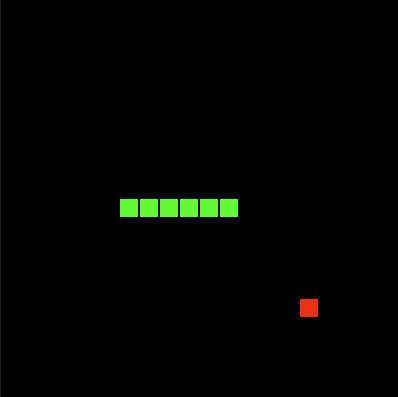Snake In 5 Minutes

This version of Snake is a port of a version of Snake written in JavaScript in 5 minutes, checkout the video - you've got 5 minutes right?
https://www.youtube.com/watch?v=xGmXxpIj6vs
Not only that but the author, Chris DeLeon of HomeTeam GameDev, also kindly posted the source code - all 69 lines of it! I've included it below for reference.
The JS below is not supposed to be good code as Chris points out in his video, it is not designed to be readable or extensible or bug free or anything like that - it's just bashing out a prototype in 5 minutes.
But it's still bloody impressive!
Anyway, ignoring the insane time factor, I found the terseness of it really interesting and wondered what it would look like if it was ported to Indigo.
Input Lag
One difference you might notice between the two is that the Indigo version appears to have input lag, or conversely, the JS version feels more responsive ...and that's because it is.
In the JS version, the velocity values are updated outside of the game loop instantly on keyboard event. You can do that sort of thing with a mutable model, but do watch out for accidental concurrency.
Indigo on the other hand is only processing those events at the next frame update every 15th of a second - 66 milliseconds - a huge amount of time between pressing the key and responding! Speculatively, the solution would probably be to increase the games frame rate to 60 FPS, but throttle snake model updates to happen every 15 FPS.
Details
Porting it wasn't completely straight forward, the main things to do were:
- Decoupling the view from the model - not so hard just required a bit of care.
- Adapting the logic to an immutable functional style.
- Some renaming and better use of types.
Considerably more than five minutes was spent porting this from JS. :-)
Original HTML/JS source code
<canvas id="gc" width="400" height="400"></canvas>
<script>
window.onload=function() {
canv=document.getElementById("gc");
ctx=canv.getContext("2d");
document.addEventListener("keydown",keyPush);
setInterval(game,1000/15);
}
px=py=10;
gs=tc=20;
ax=ay=15;
xv=yv=0;
trail=[];
tail = 5;
function game() {
px+=xv;
py+=yv;
if(px<0) {
px= tc-1;
}
if(px>tc-1) {
px= 0;
}
if(py<0) {
py= tc-1;
}
if(py>tc-1) {
py= 0;
}
ctx.fillStyle="black";
ctx.fillRect(0,0,canv.width,canv.height);
ctx.fillStyle="lime";
for(var i=0;i<trail.length;i++) {
ctx.fillRect(trail[i].x*gs,trail[i].y*gs,gs-2,gs-2);
if(trail[i].x==px && trail[i].y==py) {
tail = 5;
}
}
trail.push({x:px,y:py});
while(trail.length>tail) {
trail.shift();
}
if(ax==px && ay==py) {
tail++;
ax=Math.floor(Math.random()*tc);
ay=Math.floor(Math.random()*tc);
}
ctx.fillStyle="red";
ctx.fillRect(ax*gs,ay*gs,gs-2,gs-2);
}
function keyPush(evt) {
switch(evt.keyCode) {
case 37:
xv=-1;yv=0;
break;
case 38:
xv=0;yv=-1;
break;
case 39:
xv=1;yv=0;
break;
case 40:
xv=0;yv=1;
break;
}
}
</script>